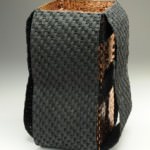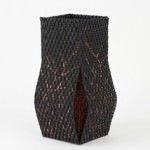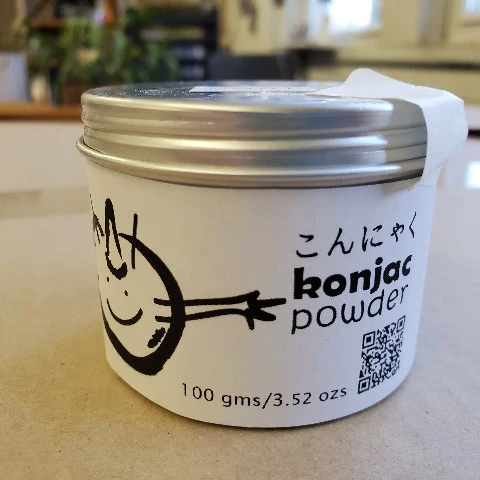March has been a very busy month for us. We have been planning for the upcoming Southern Graphics Conference, a printmaking love fest that this year is being held in Milwaukee. So printmaking methods have been in our minds, maybe a bit too much. What papers are best for lithos? Is gampi good for chine colle? , etc. (The answer, by the way, is yes, yes and yes.) However, to take a break from the wonderful world of printmaking, we turn our attention to a different, if not extraordinary application of our papers, by Arlene McGonagle. We have known Arlene for many years; she is a very faithful, loyal supporter of Paper Connection. And we love her unique approach to transforming our sheets of papers into something three dimensional, and even poetic. We will let her explain.
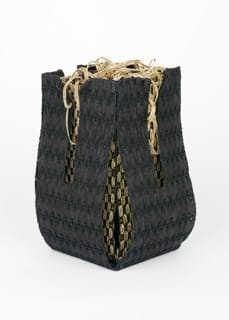
PCI: Tell us a little bit about yourself: What kind of artwork do you do?
AM: I make baskets – one of a kind sculptural baskets. I have been a traditional basket maker since 1980. I grew up on a produce farm in Hadley, Massachusetts. Baskets were part of our harvesting process in which our vegetables were all harvested using different basket styles. As a young person I was not aware of my passion for baskets, but I do believe growing up on a farm gave me the knowledge for the functional construction aspects of basket weaving.
PCI: What or who has influenced and inspired you?
AM: After making functional Nantucket and Shaker baskets for fifteen years I needed a methodology in which to become more creative in my personal form of expression. So I returned to college entering The University of Massachusetts at Dartmouth in the Fiber Arts and Textile Design Department for a Masters Degree. As a result my work and materials changed overnight. The Fiber Arts Department encouraged us to use different and unusual materials from barks to wire and everything in-between.
PCI: What attracts you to working with paper?
AM: The wide variety of texture in paper, I felt the more texture the better in the paper I use. The paper reminded me of the barks, woods, and reeds I had used in the traditional basketry process. However, the paper I chose was colorful with intricate designs and flexible without soaking it in water. It was also gentler on my hands and easier to weave.
PCI: That’s great, especially for your hands’ health too! What do you like best about working with paper?
AM: For me it’s all about texture and color. I love the thick kyosei-shi paper because it reminds me of fabric. I have been working in neutral colors lately, but this paper allows me to go wild with color if the basket calls for color. I also love the mulberry, or kozo paper for its translucent and regal qualities. When words are written on this paper it adds a note of importance and strength.
PCI: How did you hear about our company?
AM: I had heard about Paper Connection for many years, but did not know it was open to the public. So I called one day and explained that I was a basket artist looking for special textured paper and made an appointment to stop in.
PCI: Simple enough. We love your initiative. Did you have much knowledge about Japanese papers before using our papers?
AM: I had no knowledge of Japanese papers whatsoever. I fell in love with the papers offered at Paper Connection and sometimes even designed the baskets around the available papers. I learned more about paper variety and function with each visit to Paper Connection. The vast knowledge of the staff and the wonderful stories Lauren would tell about the makers of the paper helped me to realize that the paper was almost sacred and that my designs had to live up to the value of the papers I purchased.
PCI: Wow. We’re so happy and grateful to hear that. What a testimony to the artistry of the papermakers themselves! What are some of the differences between our papers and others you have worked with?
AM: I seem to keep going back to Kyosei-shi for most of my basketwork. It is physically strong and with a wide variety of colors. However, I can buy it in off-white and dye in the colors I need. I don’t know if I could dye other papers in a water bath.
PCI: So to sum up?
AM: I like kyosei-shi paper because it is strong and textured like fabric for my baskets; it is flexible and does not tear when I weave it with wire.
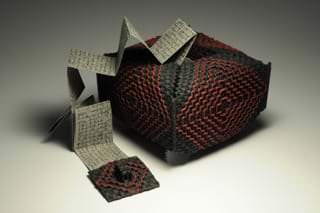
PCI: Arlene, thank you so much. We love your work, we appreciate how you use these wonderful papers, the motivation behind it, and your generous support over the many years.
For more information about Arlene, please visit her website, Basket Sculpture. Her studio is located in beautiful Warren, RI. To read more about her work, Arlene was featured in the Fall 2012 issue of the National Basketry Organization. Article courtesy of Arlene McGonagle.

